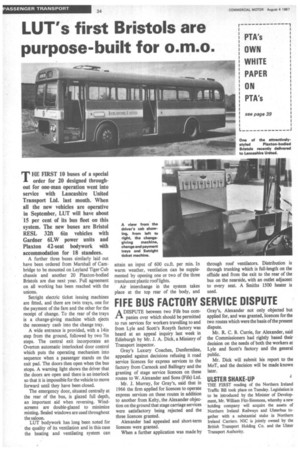LUT's first Bristols are purpose-built for o.m.o.
Page 36

If you've noticed an error in this article please click here to report it so we can fix it.
THE FIRST 10 buses of a special order for 20 designed throughout for one-man operation went into service with Lancashire United Transport Ltd. last month. When all the new vehicles are operative in September, LUT will have about 15 per cent of its bus fleet on this system. The new buses are Bristol RESL 32ft 6in vehicles with Gardner 6LW power units and Plaxton 42-seat bodywork with accommodation for 18 standees.
A further three buses similarly laid out have been ordered from Marshall of Cambridge to be mounted on Leyland Tiger Cub chassis and another 20 Plaxton-bodied Bristols are due next year. Full agreement on all working has been reached with the unions.
Setright electric ticket issuing machines are fitted, and there are twin trays, one for the payment of the fare and the other for the receipt of change. To the rear of the trays is a change-giving machine which ejects the necessary cash into the change tray.
A wide entrance is provided, with a 14in step from the ground, followed by two 7in steps. The central exit incorporates an Overton automatic interlocked door control which puts the operating mechanism into sequence when a passenger stands on the exit pad. The doors then open when the bus stops. A warning light shows the driver that the doors are open and there is an interlock so that it is impossible for the vehicle to move forward until they have been closed.
The emergency door, situated centrally at the rear of the bus, is glazed full depth, an important aid when reversing. Windscreens are double-glazed to minimize misting. Sealed windows are used throughout the saloon.
LUT bodywork has long been noted for the quality of its ventilation and in this case the heating and ventilating system can attain an input of 600 cu.ft. per min. In warm weather, ventilation can be supplemented by opening one or two of the three translucent plastic roof lights.
Air interchange in the system takes place at the top rear of the body, and through roof ventilators. Distribution is through trunking which is full-length on the offside and from the exit to the rear of the bus on the nearside, with an outlet adjacent to every seat. A Smiths 1500 heater is used.












































































































